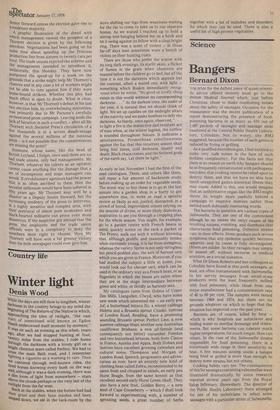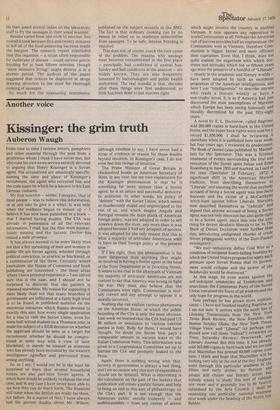Science
Bangers
Bernard Dixon
'l op prize for the daftest piece of quasi-scientific advice offered recently must go to the British Medical Journal which, just before Christmas, chose to make comforting noises about the safety of sausages. Occasion for the reassurance was the recent publication of a report demonstrating the presence of foodpoisoning bacteria in as many as 435 out of 1,467 packets of sausages and sausage meat examined at the Central Public Health Laboratory, Colindale. Not to worry, the BM J suggested, because the number of such germs is reduced by frying or grilling.
As a qualified microbiologist, I feel entitled to make very rude noises in the face of such feckless complacency. For the facts are that there is no reason on earth why bangers should be so frequently contaminated with pathogenic microbes; that cooking cannot be relied upon to destroy them; and that we have no idea how much unreported gastro-intestinal illness they may cause. Added to this, one would imagine that an authoritative organ like the BMJ might throw its weight more usefully behind a campaign to improve matters rather than behind such dubiously reassuring words.
The bacteria in question are various types of Salmonella. They are one of the commonest (though by no means the only) causes of the revolting nausea, vomiting, and diarrhoea that characterise food poisoning. Different strains vary in their effects. Some produce such severe symptoms that any epidemic quickly becomes apparent and its cause is fully investigated. Others are milder. So their ravages may simply be passed off, without recourse to medical attention, as a trivial nuisance.
What Dr Diane Roberts and her colleagues at Colindale have found is that pork sausages, at least, are often contaminated with Salmonella.
In her survey sausages from small-scale producers were the least frequently sullied with food poisoners, while those from one major manufacturer had a contamination rate of 40 to 60 per cent. The samples were tested between 1969 and 1974, but there are no grounds whatever on which to hope that the situation has improved over the past year. Bacteria are, of course, killed by heat — which is why hospitals use autoclaves and boiling water to sterilise dressings and instru ments. But some bacteria can tolerate much higher temperatures, for much longer, than can others. In the case of the Salmonella strains
responsible for food poisoning, there is a notoriously wide range -in their sensitivity to heat. A few minutes sizzing inside a banger being fried or grilled is more than enough to destroy some strains, but not others.
Cooking habits vary too. The consequences of this for sausages containing salmonellae were illustrated dramatically by some research reported several years ago from the Royal Salop Infirmary, Shrewsbury. The director of the Public Health Laboratory there arranged for one of his technicians to infect some sausages with a particular strain of Salmonella. He then asked several ladies on the laboratory staff to fry the sausages in their usual manner.
Results varied from one cook to another, but overall it took between five and twenty minutes to Rill all of the food-poisoning bacteria inside the bangers. The research report concluded that this organism — a strain often responsible for outbreaks of disease — could survive gentle frizzling for at least fifteen minutes, though "more intensive frying" might destroy it in a shorter period. The authors of the paper suggested that notices be displayed in shops drawing attention to the need for thorough cooking of sausages.
So much for the reassuring sentiments
published on the subject recently in the BMJ. The fact is that ordinary cooking can by no means be relied on to eradicate salmonellae from sausages. To be safe, intense frizzling is required.
This does not, of course, touch the root cause of the problem. The reasons why sausage meat becomes contaminated in the first place principally bad conditions of animal husbandry and bad conditions at the abattoir — are widely known. They are also frequently lamented by bacteriologists and public health authorities. The real scandal is that, decades after these things were first understood, so ,little hasbeen done to put matters right.



























 Previous page
Previous page